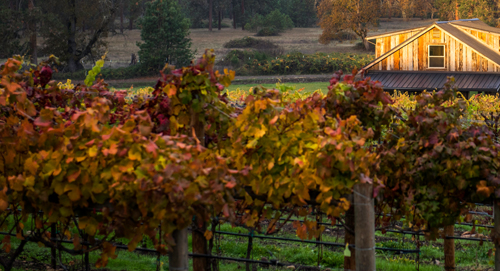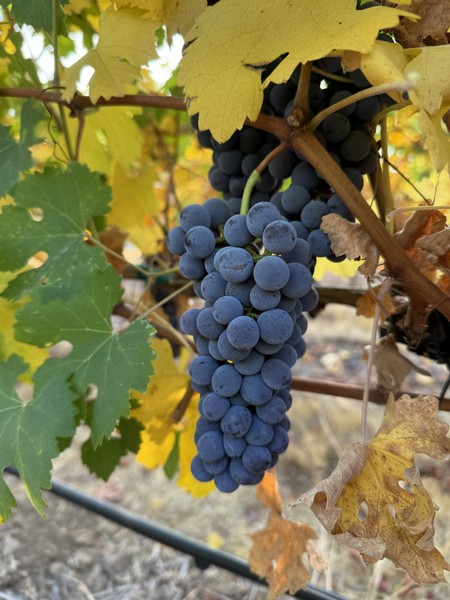Italian Varietals in The New World; History of Italian Wine in the Rogue Valley
Old World Grapes Take Root in Oregon

In the rolling hills of the emerging Rogue Valley American Viticultural Area, on a fresh, brisk early autumn morning in 2013, Jim Bayer stands among his vines, calloused hands caressing leaves that whisper secrets of a distant homeland. As the first light of dawn breaks over rows of robust vines heavy with promise, Jim's eyes gleam with the same passion that first brought him to this untested land. In his weathered hands, he cradled vines of his first Primitivo harvest, their gnarled stems a testament to centuries of winemaking heritage. He stood at the edge of his vineyard, the cool morning air carrying whispers of his visionary expedition rife with unforeseeable challenges. The story of Bayer Family estate is one of trailblazing ambition and unwavering perserverance, a parallel tale to that of the migration of old world grape varietals that have made their way to the Pacific Northwest.
In the contours of these hills, he saw echoes of the old world’s hallowed slopes, and in his heart burned a passion to prove that this land could birth wines to rival the old world's finest. As he worked the soil, Jim's mind raced with the challenges ahead.
With each careful step into the uncharted terroir, he was about to rewrite the viticultural map of this fledgling American AVA. His vineyard stands as a living homage to his ancestors, deciding to plant the Primitivo grape originally from Croatia as well as Italian varietals native to the land of his extended family. The soil, Agate Winlow, promised to impart the complex minerality that old world Croatian, Italian, and French grapes crave, while testing Jim's skill in managing his diverse array of plantings along in their vigorous growth.
Months turned to years as Jim battled the elements. Late-season rains threatened to dilute the precious fruit just as harvest approached. He countered by implementing innovative canopy management techniques, allowing just enough leaf coverage to protect the grapes while ensuring optimal ripening. The vines' susceptibility to disease kept him vigilant, his days spent walking the rows, fingers gently probing leaves for signs of trouble. But as the seasons passed, the vines took hold, their roots plunging deep into the earth, extracting flavors unique to this virgin terroir. The first harvest was a moment of breathless anticipation. As the grapes were carefully hand-picked, each perfect, taut sphere glistening like sun-kissed jewels, Jim felt a surge of triumph that year.
The “King of Wines, Wine of Kings”
Although a vineyard is an intensive operation, Nebbiolo has taken the most work, patience and innovation because it’s a fickle grape to grow. The cultivation of Nebbiolo in the Pacific Northwest represents a bold venture into uncharted viticultural territory, as winemakers and vineyard managers seek to adapt this iconic Italian grape to the region's unique terroir. The
Nebbiolo grape, particularly when used to produce Barolo wine, has long been associated with royalty and nobility. The grape’s native region, Piedmont located in northwestern Italy, is often referred to as the "valley of kings and queens" due to their royal wine associations and the exceptional quality of their Nebbiolo-based wines. In the mid-19th century, Barolo gained popularity among the Italian aristocracy, including King Vittorio Emanuele II, the first king of unified Italy. This royal connection helped cement Nebbiolo's reputation as a wine fit for kings. Nebbiolo produces some of Italy's most complex, age-worthy, and sought-after wines. Its wines are known for their powerful structure, ability to age for decades, and complex aromas and flavors.
The decision to plant Nebbiolo was not made lightly. Jim knew the grape's capricious nature, its reputation as the "heartbreak grape" that had humbled even the most seasoned vintners. Nebbiolo's early budding nature made it vulnerable to spring frosts, a constant threat in this unpredictable climate. Against the raised eyebrows of local farmers and the skepticism of agricultural experts, he dared to plant varietals that had never before tasted this soil, this air, this light. Each day brought new challenges: frost that threatened to nip his ambitions in the bud, rains that tested the mettle of his drainage systems, and wildfires that forced him to coax life from the unforgiving earth. Yet Jim worked tirelessly, his brow furrowed with concentration as he listened to the land, learning its rhythms and moods as intimately as one knows a lifelong companion. He meticulously selected the most favorable slopes, hoping to coax every precious ray of sunshine onto his vines during the long growing season.
As the seasons turned, so did the tide of fortune. The vines not only survived but thrived, their roots digging deep into the terroir, extracting flavors unknown to the New World palate. The Bayer Family Estate plot of earth, once deemed inhospitable to the noble grape, now thrums with the quiet determination of tender shoots reaching for the sun. The Bayer Family Estate vineyard became a bridge between two worlds – a testament to old-world craftsmanship flourishing in the untamed potential of American soil. In this young and burgeoning Rogue Valley AVA, Jim Bayer has not just planted vines; he has sown the seeds of a new tradition, one that honors the past while fearlessly embracing the possibilities of tomorrow.
In the winery, Nebbiolo's notoriously high tannins and acidity demanded a deft touch and put our winemaker’s skills to the test. It took ambitious experimentation, balancing traditional techniques with modern innovations. Oak barrels were carefully selected, their influence on the wine monitored with painstaking precision. Finally, after some toil and countless checks and rechecks, in 2016 Jim held in his hands a bottle of his inaugural Nebbiolo vintage. The pale garnet liquid shimmered in the light, belying the power and complexity within. As he raised the glass to his lips, aromas of wild roses, tar, and sun-baked earth transported him back to the hills of Piedmont.
The wine was a revelation – a harmonious blend of old-world soul and new-world vitality. It spoke eloquently of its Italian heritage while singing with the unique voice of its adopted homeland. As word spread and critics took notice, The Bayer Family Estate Nebbiolo became more than just a wine; it became a symbol of the potential lying dormant in this unsung AVA, waiting for visionaries bold enough to unlock it. With each passing harvest, Bayer Nebbiolo vines flourished in their new terroir and continued to evolve, a living testament to the power of passion, perseverance, and the indomitable spirit of a dreamer who dared to challenge the established order of the wine world.
His story, while unique, echoes a broader narrative that has been unfolding for over a century—a tale of Italian immigrants and their descendants reshaping the viticultural landscape of America with the same passion and expertise that defined their ancestral homeland. From the sun-drenched valleys of California to the misty hills of Oregon and Washington, Italian varietals and winemaking traditions have woven themselves into the fabric of American viticulture. This journey, much like Bayer Family Estate's, has been one of perseverance, innovation, and a deep-seated belief in the potential of new lands to produce wines that honor old-world heritage while embracing new-world possibilities. As we explore this rich history, we see how figures like Jim Bayer stand on the shoulders of generations of Italian-American vintners who dared to dream of Sangiovese alongside Cabernet, and Barbera beside Pinot Noir, forever changing the face of American wine.
The Italian-American influence on the U.S. wine industry has been profound and enduring. Pioneering families like Gallo, Mondavi, Martini, and Sebastiani played pivotal roles in shaping the American wine landscape. These immigrants didn't just bring their labor and expertise; they carried with them a rich wine culture deeply rooted in their Italian heritage.
The "Suitcase Vineyard" Phenomenon
Italian immigrants ingeniously transported their viticultural heritage across the Atlantic. It is said that early Italian settlers would smuggle grape vine cuttings in their luggage when traveling to California. This clandestine importation of grape varieties led to the creation of diverse vineyards with an eclectic mix of grape types, earning them the moniker "suitcase vineyards."
When Italian immigrants arrived in America in large numbers during the late 19th and early 20th centuries, they brought with them not only their labor but also their deep-rooted wine traditions. Many of these immigrants came from wine-producing regions in Italy and naturally sought to continue their viticultural practices in their new home. Italian immigrants introduced numerous grape varieties that were previously unknown in America. Varieties like Sangiovese, Nebbiolo, and Barbera found new homes in California and other wine-growing regions. This diversification expanded the palette of American wines and challenged the dominance of French varieties.
Winemaking Techniques and Traditions
Italian winemakers brought with them traditional techniques that were adapted to New World conditions. The Italian tradition of blending different grape varieties to create balanced wines
influenced American winemaking practices. The use of large oak casks for aging, common in Italy, was introduced alongside the French practice of using smaller barriques. Many Italian-American wineries embraced sustainable and organic viticulture, drawing on traditional Italian farming methods.
The Italian approach to wine as an integral part of daily life and meals gradually influenced American wine culture. The Italian tradition of enjoying wine as part of a meal helped shift American perceptions of wine from a luxury item to an everyday pleasure.
Today, the legacy of Italian-American winemakers continues to shape the industry and at Bayer Family Estate we’re carrying on this tradition. We aspire to continue to be an esteemed Southern Oregon wine producer utilizing hybrid approaches combining Old World Italian techniques with New World technologies and innovations. Every glass we pour in our Tuscan style inspired tasting room is a call for rediscovery of a heritage, as we continue to contribute to a growing trend of exploring lesser-known Italian varieties and reviving traditional winemaking methods. The Bayer Family Estate Italian-American wines have gained national acclaim, competing with established Old World producers and elevating the status of Southern Oregon wine country amongst the Pacific Northwest and across the nation